Unlike many Chinese families, our family never really participated in the traditional Lunar New Year activities growing up. My parents would give me and my sister the obligatory red envelope (利市 lai see or 红包 hong bao), but that was about it. It wasn’t until I spent more time with my husband’s family that I learned more about the traditions and foods that surround the Lunar New Year. We eat symbolic foods like apples (蘋果 ping guo) that represent peace (平安 ping an), noodles — never cut — for longevity, and fish (éšÂ yu) for abundance (有余 you yu). (A lot of the association comes from the words sounding alike.) And of course, there are dumplings (known as 餃å jiaozi when boiled or é‹è²¼Â guotie when panfried), which represent wealth and prosperity because they have the shape of gold nuggets, the ancient Chinese currency for money.
When I visited my sister in Beijing about a year and a half ago, she and I took a noodle and dumpling class from a former Beijing chef. He shared with us many tips for making perfect dumplings, which I’ll also share with you in the primer that follows below.

Take a look at these professionally folded dumplings by our teacher, after 20 + years of practice. Someday, I hope to make dumplings this beautiful!
Back in the US, I hardly ever made my own dumpling wrappers since store-bought ones were so much more convenient. But during my two years in Grenada, I really got the chance to practice my skills at making wrappers because, like most other Asian foods, they were impossible to find on the island! If I ever wanted to eat dumplings, I knew I’d have to make them from scratch. Luckily, I wasn’t the only one in Grenada who missed them, so my friends and I would often spend afternoons making absurd quantities of dumplings together and then share the loot. It’s really the perfect group activity. Funnily enough, store-bought dumpling wrappers are not that common in Beijing either because everyone makes them from scratch!
Toward the end of my visit to Beijing, I was on the hunt for a dumpling roller to take home with me. I kinda waited until the last minute, and I didn’t have any luck at the couple of grocery stores and shops I went to. Finally, on my last morning, as I was out picking up breakfast with my sister and her family, we happened upon a vendor rolling breakfast buns with exactly the kind of dumpling roller I was searching for. Unlike the light wood ones that stores typically sell (see photo above), his was a beautiful shade of dark brown (see photo below). I asked him if dumpling rollers were available to purchase anywhere nearby, and he responded with a very definitive no. I asked him if he’d be willing to sell me his, and after much hesitation, he went on a long spiel about how he carefully selects each piece of Chinese mahogany wood for his rollers, and then crafts each of them by hand. He pulled out a second back-up roller from the back of the stall and said these were the only two he had. I finally made him an offer he couldn’t refuse, and he very nonchalantly agreed to sell me one. I ended up paying 50rmb, about $8 — which is probably much more than one would cost in a grocery store but seemed like a steal to me for something crafted by hand, made of better wood, and bearing such beautiful patina from age and use by a Beijing dumpling maker. Plus, it now came with a great story. It’s still my favorite souvenir from Beijing!
So now, let me share with you my favorite tips for making dumplings, just in time for Chinese New year. Round up your family, your children, or a group of friends for a day of dumpling-making! It’s become one of my favorite ways to spend time with new friends and people I love. I often tell my sister that I think in another life, I could be a dumpling maker. :)
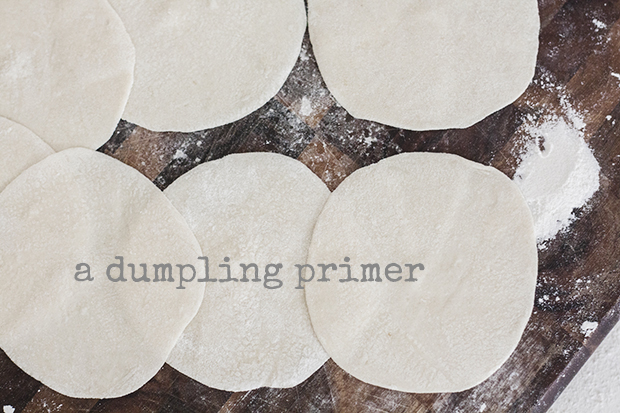
Ingredient List
Adapted from Asian Dumplings by Andrea Nguyen
DOUGH
2 cups all-purpose flour
3â„4 cup warm water
FILLING
2 cups finely chopped Napa cabbage or regular cabbage
2/3 lb ground pork or turkey (I used turkey here to make it healthier, but pork is more traditional)
1/3 cup minced Shiitake mushrooms (if using dried, soak in hot water for 20 minutes to rehydrate)
1â„2 tsp salt
1 Tbsp grated ginger
1â„3 cup chopped Chinese chives or scallions (Chinese chives are the traditional ingredient, but if you don’t like the flavor, you can substitute scallions)
1 egg
2 cloves garlic, minced
1â„4 tsp black pepper
1 1â„2 Tbsp soy sauce
1/2 Tbsp oil
1 1â„2 Tbsp sesame oil
1 Tbsp rice wine
DIPPING SAUCE
1/3 cup soy sauce
2 1â„2 Tbsp rice vinegar
(or 1 Tbsp white vinegar + 1 Tbsp water + 1â„4 Tbsp sugar)
2 tsp minced garlic
chili oil (optional)
Process
MAKING THE DOUGH
People who make dumplings regularly, like the chef we took our class from or even my sister’s ayi (nanny) in Beijing, rarely use recipes for this dough. They gauge the proportions of water to flour by the feel of the dough and adjust accordingly. The dough can feel very different depending on the humidity of your environment, the amount and type of flour used, and even the amount and temperature of the water. So take all these factors into consideration when trying your hand at dumpling dough. In the end, it all just comes down to practice.Â

 1. Put the flour in a bowl and make a well in the center. Pour the water in and stir (either with your hand or with a spoon), evenly moistening the flour. Gently mix until all the lumpy bits have been incorporated. Add more flour or water as necessary. The dough should start looking shaggy and hold its shape when pinched, but it shouldn’t be too moist.
1. Put the flour in a bowl and make a well in the center. Pour the water in and stir (either with your hand or with a spoon), evenly moistening the flour. Gently mix until all the lumpy bits have been incorporated. Add more flour or water as necessary. The dough should start looking shaggy and hold its shape when pinched, but it shouldn’t be too moist.

2. Transfer the dough to a lightly floured surface and knead the dough with the heel of your hand for about 2 minutes. The dough should be nearly smooth and somewhat elastic. Press down on the dough; the impression should slowly bounce back.
 3. Smooth out the top of the dough and pinch the ends together on the bottom. Place the dough in a Ziplock bag and let it rest (alternatively, you can put it in a bowl and cover with a plate).
3. Smooth out the top of the dough and pinch the ends together on the bottom. Place the dough in a Ziplock bag and let it rest (alternatively, you can put it in a bowl and cover with a plate).
PREPARING THE FILLING
While the dough is resting, use this time to prepare your ingredients for the filling. Filling can be made ahead and refrigerated overnight. Letting it sit for a few hours or overnight can help bring out the flavors, but it’s not absolutely necessary if you’re short on time. There are all sorts of fillings you can put inside a dumpling, but here I have stuck with some of the classic ingredients.
4. Combine all the filling ingredients in a large mixing bowl. Add seasonings and mix well. Use your hands!
FORMING THE DUMPLING WRAPPERS
This might just be my favorite part of making dumplings! It is so much fun, and I love the challenge of trying to make the perfectly round and thin wrapper.Â
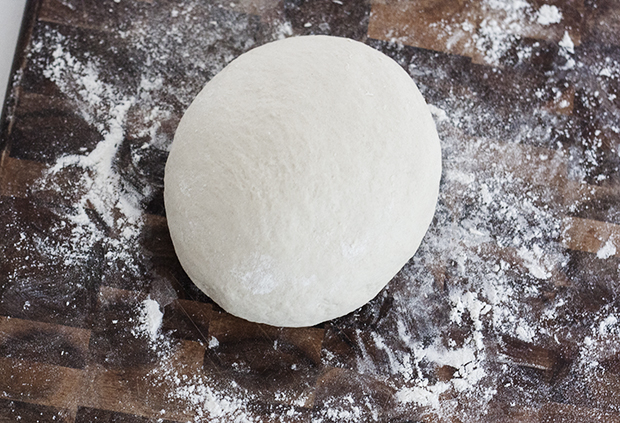
5. Remove the dough from the bag and place on a floured surface.
6. Cut the dough into thirds and put two of the thirds back into the bag. Seal completely.

 7. Roll the remaining third of the dough into a 1-inch thick log. Cut the log into even pieces, about 3/4 ” thick each. (If the ends of the log are thinner, make those cuts a bit longer, about 1″ thick.) Now here is the trick I learned in the dumpling class:Â After each cut, rotate the log a quarter turn, so that the dough pieces are pinched in different directions on each side (see photo above). As you’ll soon see, this is an important step in forming perfectly circular dumpling wrappers!
7. Roll the remaining third of the dough into a 1-inch thick log. Cut the log into even pieces, about 3/4 ” thick each. (If the ends of the log are thinner, make those cuts a bit longer, about 1″ thick.) Now here is the trick I learned in the dumpling class:Â After each cut, rotate the log a quarter turn, so that the dough pieces are pinched in different directions on each side (see photo above). As you’ll soon see, this is an important step in forming perfectly circular dumpling wrappers!
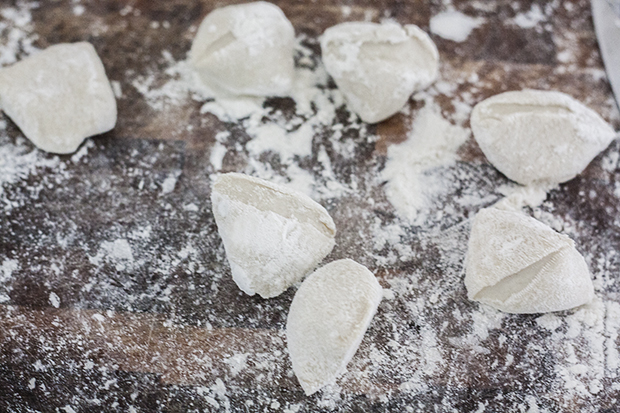
8. Roll the pieces lightly in flour and then set each piece on one of its cut ends. Flatten each piece of dough with the palm of your hand. Because of the quarter turn when cutting, the dough will naturally flatten into the shape of a circle. How brilliant, right? :) Without the turn, you’d get more of an oval shape, due to the way the knife pinches the dough flat. Then, if you take as much delight in this process as I do, you can simply reshape any pieces that don’t look as perfectly round as they should. :)

9. To roll the wrappers, start with a lightly floured surface. If you’re right-handed like me, hold one of the flattened pieces of dough in your left hand and the wooden rolling pin in your right. You’ll want to roll the rolling pin gently back and forth, while turning the dough in a counter-clockwise motion in your left hand. Roll up about 1/2″ – 1″ in from the edge, avoiding the center of the dough completely. This way, you’ll leave the center a little thicker — perfect for holding the heavy filling — while making the edges a little thinner — perfect for making delicate pleats to seal the top. After the dumplings are folded and the outer edges pressed together, the thicker center will have about the same amount of doughiness as the outer pleated edges. I love how perfectly this all works out. :)

10. Continue rolling until you have about 10 wrappers to work with. You don’t want to roll too many at a time, or else they will start to dry out (unless you have a partner to fill the dumplings while you roll!).
11. Fill your wrappers with about 1 tablespoon of filling. Flatten the filling a bit in the center. Fold using your favorite method! The Beijing method for boiled dumplings is very easy and involves simply folding the wrapper over, and then pinching it shut by holding the edges between thumbs and index fingers of both hands. Andrea Nguyen also has some fantastic videos on basic dumpling folds here and here (I tend to use the method in the second video).

At this point, your dumplings are ready to be fried, boiled, steamed, or frozen. I like to make a huge batch of dumplings and freeze them for later use. Be sure to put them on a nonstick tray (lined with freezer paper, or a Silpat mat works well) and space them out individually in the freezer; otherwise they will stick together and be impossible to separate once defrosted. After 30 minutes or more, the dumplings are frozen enough that you can place them all into a Ziploc bag for quick and easy meals. Frozen dumplings do not need to be defrosted before cooking — just add a few minutes of extra cooking time to each of the three methods below.
COOKING THE DUMPLINGS: 3 ways to cook fresh or frozen dumplings
My favorite go-to method for cooking dumplings is in a frying pan. I love the crispy bottoms and tender, steamed tops. Here’s how to get perfectly cooked dumplings every time:
Panfry
 1. Heat up 1-2 tablespoons of vegetable oil in a non-stick pan on medium-high heat. When the pan is hot, add in the dumplings in a single layer. Arrange them in a circular shape, allowing them to hug one another. Leave about 1/8″ between each dumpling because they will plump up.
1. Heat up 1-2 tablespoons of vegetable oil in a non-stick pan on medium-high heat. When the pan is hot, add in the dumplings in a single layer. Arrange them in a circular shape, allowing them to hug one another. Leave about 1/8″ between each dumpling because they will plump up.
2. Let the dumplings fry until the bottoms are golden brown.
3. Add in about 1/3 cup water (until there is about 1/4†of water in the pan) and cover with a lid. Let them steam for about 5-7 minutes, until you hear the dumplings begin to sizzle after all the water has evaporated.

4. Remove the lid. The dumplings should look translucent at this point. Fry just a little bit longer, until the bottoms are crispy again.

5. For a nice presentation, find a plate just slightly smaller than your frying pan. First flip the plate onto the dumplings in the pan, and then invert the pan of dumplings onto the plate.
6. Serve immediately with dipping sauce. Enjoy!
Boil
Place dumplings into boiling water. When the dumplings begin to float, cook for an additional 5-6 minutes. Remove carefully with a slotted spoon. I tend to think this is best served in soup. In Beijing, though, they’re just eaten as is dipped in some vinegar. Traditional Beijingers even drink the flour water that the dumplings were boiled in!
Steam
Bring 3 cups of water to a boil in a large wok. Place dumplings into a bamboo steamer basket and place into the wok. Steam for 8 minutes. Serve immediately.







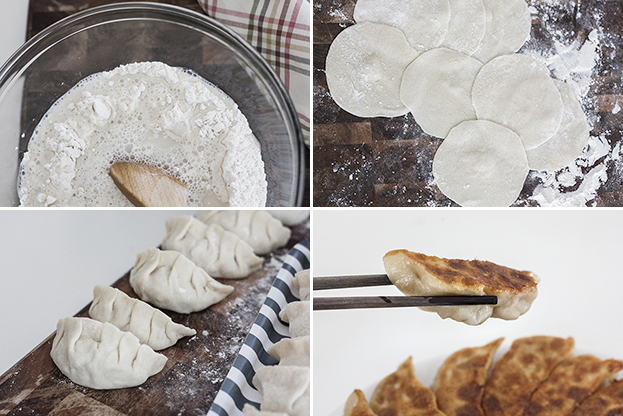


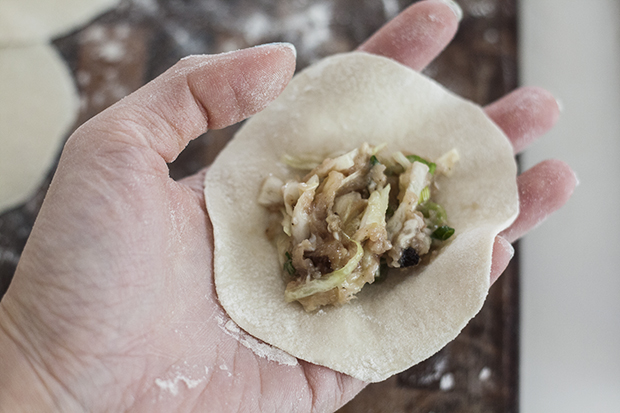
















Connect with us